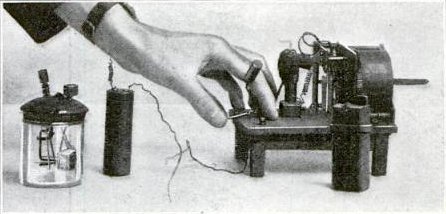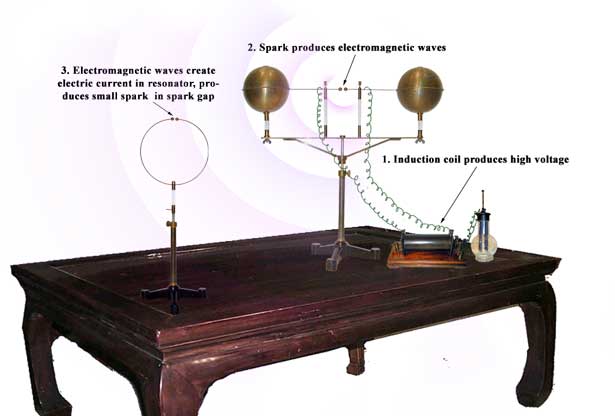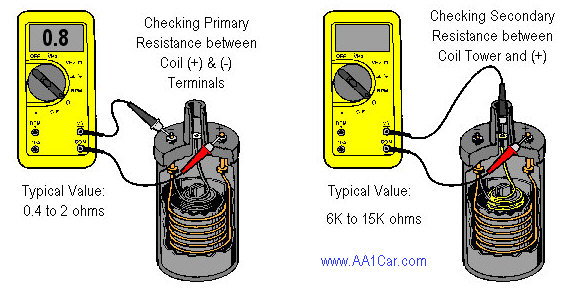In this modern age of high tech gadgets, it is easy to take the technology around us for granted. If we look at the world around us as if we have never seen it before, it would be impossible not to be filled with awe and wonder. In this article, I will tell you the story behind one of the most important technological inventions of modern times - wireless communication. I will also describe some of my own experiments with high voltage spark transmitters and coherers! But before I talk about those, a little background is necessary to appreciate how they work. We’ll have to step into the shoes of the early pioneers in the field of electricity and see the world in a completely different way!
Many years ago, when there were no cell phones or Internet, a great scientist by the name of Michael Faraday speculated the existence of electromagnetic waves when he observed the influence of magnetic fields on polarized light (Faraday Effect). Faraday speculated that light could be a form of electromagnetic disturbance propagating through space. However, this idea was received with considerable skepticism, and it was rejected by everyone until a mathematician by the name of James Clerk Maxwell proved it mathematically in his paper “The Dynamical Theory of the Electromagnetic Field” (1865). Maxwell predicted the existence of electromagnetic waves that could travel indefinitely at the speed of light until absorbed. He proved their existence mathematically without any experimental proof.
About thirteen years later, David Edward Hughes (an Anglo-American concertina player and inventor) observed something very bizarre. When working on his Induction Balance, a loose contact was creating sparks. Hughes noticed that a telephone circuit connected to his carbon microphone on the other side of the room was somehow picking up that noise. He took the telephone circuit outside, and he could still hear the clicks made from the induction coil up to 500 yards away! You could consider this the first mobile phone call in history. Hughes wrote -
“Further researches proved that an interrupted current in any coil gave out at each interruption such intense extra currents that the whole atmosphere of the room (or in several rooms distant) would have a momentary invisible charge, which became evident if a microphonic joint was used as a receiver with a telephone. This led me to experiment upon the best form of a receiver for these invisible electric waves, which evidently permeated great distances, and through all apparent obstacles such as walls &c. I found that all microphonic contacts or joints are extremely sensitive.”
Apparently, when Hughes showed this to members of the Royal Society, the scientists thought it was merely the result of induction. They did not realize that Hughes had accidentally discovered the electromagnetic waves that Maxwell and Faraday had predicted. Hughes never published his findings.
 |
| Hughes wireless apparatus, a modified version of his carbon microphone detector (left), and a clockwork driven spark transmitter and battery (right) (source) |
In the 1880s, physicist Heinrich Hertz was trying to confirm the existence of Maxwell’s electromagnetic waves. After observing induced sparking in a Riess spiral, Hertz concluded that this phenomenon could be used to detect the waves. He set up a spark gap transmitter, and a receiver (which consisted of wire loop with a small spark gap). Hertz thought that if the spark gap transmitter created electromagnetic waves, the wire loop antenna would pick it up, and he would see a small spark at the gap in the antenna. Hertz would look at that gap in a dark room with a magnifying glass to see if any sparks appeared.
 |
| source: http://www.sparkmuseum.com/ |
Around the same time, a scientist named Oliver Lodge was investigating some issues with lightning rods. To simulate lightning, he was using two Leyden jars to create high voltage sparks. He had two wires connected to the gap (as shown in the figure below) with multiple spark gaps between them. He observed that when the Leyden jars discharged, sparks appeared at all the spark gaps simultaneously. He also noticed that sparks at certain locations were more intense than others. In a darkened room, he could clearly see a visible glow between the wires at one-half wavelength intervals. When Lodge saw this pattern, he knew that he had discovered the electromagnetic waves predicted by Maxwell.
 |
| Oliver Lodge's experiment (source: "Oliver Lodge: Almost the Father of Radio" by James Rybak) |
Hertz also saw the spark he was hoping to see. Through the experiments of Lodge and Hertz, the existence of Maxwell’s elusive electromagnetic waves was finally confirmed.
Lodge went on to design better devices (detectors) to detect these waves. The detector that Lodge used was called a “coherer”. I think it was based on the idea of Hughe’s carbon microphone detector. A coherer consists of iron filings between two electrodes. Normally, the resistance between the two electrodes is very high. When a spark is created, the resistance between the electrodes drops.
My homemade coherer
After reading the story behind the discovery of electromagnetic waves, I wanted to make my own coherer. The amazing thing about the coherer is how simple it is. Why it works is also mysterious. It seems the electromagnetic waves somehow magnetize the filings, and they get closer to each other. I built my coherer inside a vinyl tube with iron filings between two ¼” bolts.
I noticed that a very small amount of filings is required between the bolts for the coherer to work. Also, the performance of the coherer depends a lot on the gap between the bolts. I adjust the gap by first pushing the bolts until my multimeter (in continuity checking mode) beeps. Then, I pull the bolts out just a little until it stops beeping. That seems to be the perfect gap. Normally, the resistance between the two bolts will be very high - in megaohms. When the coherer detects electromagnetic waves, the resistance drops to 10-20 ohms. Normally the coherer will stay in this state of low resistance, and you have to tap it to decohere it. I am thinking about making an automatic tapping mechanism with an electromagnet.
Spark-gap transmitter
To test my coherer, I used a piezoelectric stove lighter. The electric spark created by the lighter was able to trigger the coherer, but it was not very reliable. So, I decided to build a better spark transmitter. I went to a junkyard and salvaged an ignition coil from a car. An ignition coil is a step-up transformer which converts 12V (from the car’s battery) to 20,000V-30,000V. This high voltage is sent to the spark plug to create sparks.
There are different kinds of ignition coils. To identify the coils, you could measure the resistance on the primary and secondary coils. The primary coil should have a very low resistance in the range of 0.4 to 2 ohms, and the secondary should have high resistance in the range of 6K to 15K ohms.
 |
| source: http://www.aa1car.com/library/ignition_coils.htm |
To test the coil, I connected a 9V battery to the coil’s primary. That was enough to create a spark on the secondary coil. When I told my dad about it, he shared his wisdom on how a car’s ignition system works, and said that I could improve the sparks if I add a capacitor across the contact point. In a car’s ignition system, there is a capacitor (aka condenser) across the contact breaker. This capacitor absorbs the back-EMF generated by the ignition coil, and reduces arcing on the primary side. This has two benefits. The first is that it improves the life of the contact breaker by reducing burning, and the second benefit is that it results in more intense sparks on the secondary. This is because the magnetic field collapses quicker when the capacitor absorbs the transient back-EMF generated on the primary side, and this increases the induced EMF on the secondary.
So, I looked around in my workspace for a capacitor with a high enough voltage rating, but didn’t find any. Then, I got an idea while watching BBC’s “Shock and Awe: The Story of Electricity” presented by Jim Al-Khalili). In this show, they described how a Dutch scientist by the name of Pieter van Musschenbroek discovered how to store electricity. Before Musschenbroek’s discovery, people could generate electricity with devices like the Hauksbee generator, but did not know how to store it. In those days, people believed that electricity was like an invisible fluid. Using this analogy, Musschenbroek thought that if electricity is like a fluid, it should be possible to store it in a jar, just like we store water! So, he filled a jar with water, and used that to store electricity. He made what’s called a Leiden (or Leyden) jar (named after a Dutch town named Leiden). The Leyden jar was the first capacitor.
| Musschenbroek's Leyden jar (source) |
Later, I designed an ignition coil driver circuit using a 555 timer for continuous sparks. After a lot of trial and error, and blowing several 555s, this circuit seems to be working reliably.
You could adjust the potentiometers to change the 555’s output waveform, and this also changes the quality of the sparks.
I have also tried connecting two ignition coils (in reverse-parallel configuration) to increase the output voltage. Based on the length of the spark gap and the dielectric breakdown voltage of air, I estimated the voltage to be somewhere around 60,000V! Be very careful when doing these experiments. Contrary to what you may want to believe, 60kV shocks don’t exactly feel pleasant (words of experience). I got lucky. Seriously, be very careful when working with high voltages. Carelessness could be fatal. Don’t get close to the spark gap or to any antenna connected to the transmitter.
Anyway, here’s a video of my spark transmitter and coherer:
This transmitter can reliably trigger the coherer from a distance. I’m now thinking of ways to extend the range. Back in the day, when spark-transmitters were actually used for communication, people realized that adding a high voltage capacitor on the coil’s secondary could increase the gap current by orders of magnitude without changing the transmitter input power. See “How Spark Transmitter’s Work” by Hal Kennedy.
A tuning coil and capacitor could be added to the ignition coil’s secondary to form a tuned circuit. When the capacitor is fully charged, it will discharge through the tuning coil and spark gap which will cause the capacitor and tuning coil to resonate at their resonant frequency. This will reduce the bandwidth of the electromagnetic waves created from the sparks and increase the range of the transmissions.
| source: “How Spark Transmitters Work” by Hal Kennedy |
By the way, when you have high voltage at your disposal, don’t miss the opportunity to make a Jacbob’s ladder, just like Dr. Frankenstein!
| “It’s alive! It’s alive!” - Dr. Frankenstein |
Dec 24th is also the anniversary of Fessenden's Dec 24th 1906 Christmas Eve broadcast.
ReplyDeletehttps://en.wikipedia.org/wiki/Reginald_Fessenden
Nice presentation,
ReplyDeleteIf you don't know history of electronics, you know nothing ...
Merry Christmas and Happy New Year!
- Asko.
thanks for sharing
ReplyDeleteHi, ashish i wander if you can provide a more clear picture as the one dipecting the 555 ignition coil driver isn't clear or give me the list of components like the mosfet or the npn transistor. Thanks in advance
ReplyDeleteHi thanks for sharing tthis
ReplyDelete